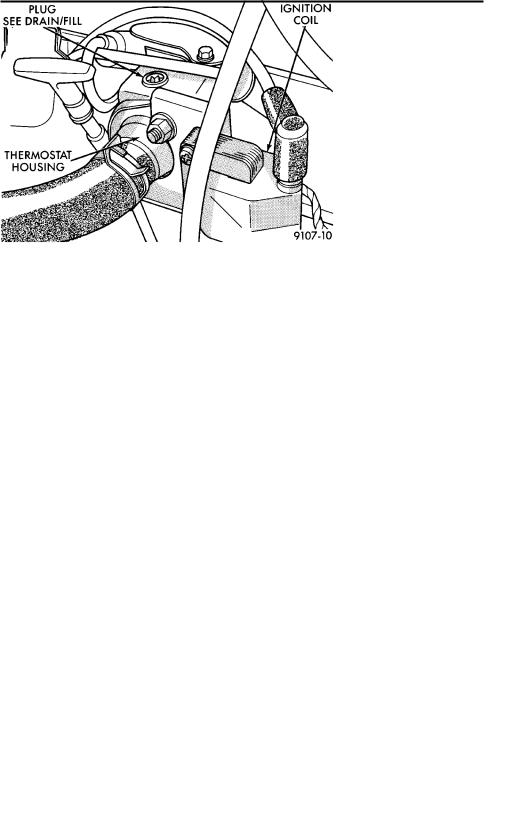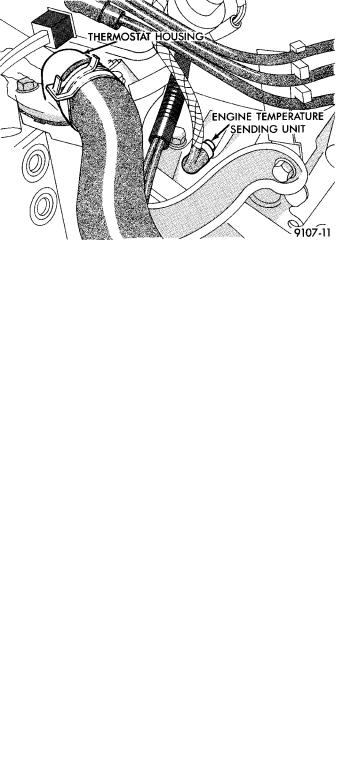
- •GENERAL INFORMATION
- •COOLING SYSTEM
- •TURBOCHARGER COOLANT ROUTING
- •COOLING SYSTEM DIAGNOSIS
- •COOLING SYSTEM DIAGNOSIS
- •COOLING SYSTEM DIAGNOSIS
- •COOLING SYSTEM DIAGNOSIS
- •COOLING SYSTEM DIAGNOSIS
- •COOLING SYSTEM DIAGNOSIS
- •SERVICE PROCEDURES
- •WATER PUMPS
- •ENGINE THERMOSTATS
- •DESCRIPTION AND OPERATION
- •OPERATION AND TESTING
- •REMOVAL
- •COOLANT
- •PERFORMANCE
- •SELECTION AND ADDITIVES
- •SERVICE
- •ROUTINE LEVEL CHECK
- •ADDING ADDITIONAL COOLANT
- •SERVICE COOLANT LEVEL
- •LOW COOLANT LEVEL AERATION
- •DEAERATION
- •COOLING SYSTEM DRAIN, CLEAN, FLUSH AND REFILL
- •DRAINING
- •CLEANING
- •REVERSE FLUSHING
- •CHEMICAL CLEANING
- •REFILLING
- •TESTING SYSTEM FOR LEAKS
- •COOLANT RECOVERY SYSTEM (CRS)
- •RADIATOR PRESSURE CAP
- •PRESSURE TESTING RADIATOR CAPS
- •INSPECTION
- •RADIATORS
- •RADIATOR DRAINCOCK SERVICE
- •RADIATOR COOLANT FLOW CHECK
- •RADIATOR
- •RADIATOR HOSES
- •FANS
- •SINGLE FAN
- •REMOVAL
- •INSTALLATION
- •TEMPERATURE GAUGE INDICATION
- •ELECTRIC FAN MOTOR
- •ELECTRIC FAN MOTOR TEST
- •FAN SHROUD
- •AUTOMATIC TRANSMISSION OIL COOLERS
- •ACCESSORY DRIVE BELTS
- •GENERAL INFORMATION
- •PROPER BELT TENSION
- •ACCESSORY DRIVE BELTS DIAGNOSIS
- •AIR CONDITIONING COMPRESSOR
- •ALTERNATOR BELT
- •AIR CONDITIONING BELT
- •ALTERNATOR, POWER STEERING PUMP, AIR CONDITIONING COMPRESSOR AND WATER PUMP DRIVE BELT
- •ENGINE BLOCK HEATER
- •DESCRIPTION AND OPERATION
- •REMOVAL
- •INSTALLATION
- •SPECIFICATIONS

7 - 16 COOLING SYSTEM
-37°C (-35°F) to -59°C (-50°F). If it looses color or becomes contaminated, drain, flush, and replace with fresh properly mixed solution.
SERVICE
Coolant should be changed at 52,500 miles or three years, whichever occurs first, then every two years or 30,000 miles.
ROUTINE LEVEL CHECK
Do not remove radiator cap for routine coolant level inspections.
The coolant reserve system provides a quick visual method for determining the coolant level without removing the radiator cap. Simply observe, with the engine idling and warmed up to normal operating temperature, that the level of the coolant in the reserve tank (Figs. 5 and 6) is between the minimum and maximum marks.
ADDING ADDITIONAL COOLANT
The radiator cap should not be removed. When additional coolant is needed to maintain this level, it should be added to the coolant reserve tank. Use only 50/50 concentration of ethylene glycol type antifreeze and water.
SERVICE COOLANT LEVEL
The cooling system is closed and designed to maintain coolant level to the top of the radiator.
When servicing requires a coolant level check in the radiator, the engine must be off and not under pressure. Drain several ounces of coolant from the radiator drain cock while observing the Coolant Recovery System (CRS) Tank. Coolant level in the CRS tank should drop slightly. Then remove the radiator cap. The radiator should be full to the top. If not, and the coolant level in the CRS tank is at the MIN mark there is a air leak in the CRS system. Check hose or hose connections to the CRS tank, radiator filler neck or the pressure cap seal to the radiator filler neck for leaks.
LOW COOLANT LEVEL AERATION
Low coolant level in a cross flow radiator will equalize in both tanks with engine off. With engine at running operating temperature the high pressure inlet tank runs full and the low pressure outlet tank drops. If this level drops below the top of the transmission oil cooler, air will be sucked into the water pump:
²Transmission oil will become hotter.
²High reading shown on the temperature gauge.
²Air in the coolant will also cause loss of flow through the heater.
²Exhaust gas leaks into the coolant can also cause the same problems.
Ä
DEAERATION
Air can only be removed from the system by gathering under the pressure cap. On the next heat up it will be pushed past the pressure cap into the CRS tank by thermal expansion of the coolant. It then escapes to the atmosphere in the CRS tank and is replaced with solid coolant on cool down.
COOLING SYSTEM DRAIN, CLEAN, FLUSH AND REFILL
Drain, flush, and fill the cooling system at the mileage or time intervals specified in the Maintenance Schedule in this Group. If the solution is dirty or rusty or contains a considerable amount of sediment, clean and flush with a reliable cooling system cleaner. Care should be taken in disposing of the used engine coolant from your vehicle. Check governmental regulations for disposal of used engine coolant.
DRAINING
To drain cooling system move temperature selector for heater to full heat with engine running (to provide vacuum for actuation). Without removing radiator pressure cap and with system not under pressure, Shut engine off and open draincock. The coolant reserve tank (Fig. 5) should empty first, then remove radiator pressure cap. (if not, see Testing Cooling System for leaks). To vent 2.2/2.5L engines remove the plug above thermostat housing (Fig. 1). For Turbo III engines remove coolant temperature sensor in the thermostat housing (Fig. 2). For 3.3L /3.8L engine remove the engine temperature sending unit (Fig. 3).
Fig. 1 Thermostat Housing Drain/Fill PlugÐ2.2/2.5L
Engines
Removal of a plug or other component is required because the thermostat has no air vent and prevents air flow through it. This allows the coolant to drain from the engine block.

Ä |
|
COOLING SYSTEM 7 - 17 |
|
Fig. 2 Coolant Temperature SensorÐTurbo III
Drain/Fill
CLEANING
Drain cooling system (see: Draining Cooling System ) and refill with clean water (see: Refilling Cooling System ). Run engine with radiator cap installed until upper radiator hose is hot. Stop engine and drain water from system. If water is dirty, fill, run and drain system again until water runs clear.
REVERSE FLUSHING
Reverse flushing of the cooling system is the forcing of water through the cooling system, using air pressure in a direction opposite to that of the normal flow of water. This is only necessary with dirty systems and evidence of partial plugging.
Fig. 3 Engine Temperature Sending UnitÐ3.3L and
3.8L Drain/Fill
RADIATOR
Drain cooling system and remove radiator hoses from engine. Install suitable flushing gun in radiator lower hose. Fill radiator with clean water and turn on air in short blasts.
CAUTION: Internal radiator pressure must not exceed 138 kPa (20 psi) as damage to radiator may result. Continue this procedure until water runs clear.
ENGINE
Drain radiator (see: Draining Cooling System ) and remove hoses from radiator. Remove engine thermostat and reinstall thermostat housing. Install suitable flushing gun to thermostat housing hose. Turn on water, and when engine is filled, turn on air, but no higher than 138 kPa (20 psi) in short blasts. Allow engine to fill between blasts of air. Continue this procedure until water runs clean. Install thermostat using a new housing gasket. Fill cooling system (See
Refilling Cooling System ).
CHEMICAL CLEANING
One type of corrosion encountered with aluminum cylinder heads is aluminum hydroxide deposits. Corrosion products are carried to the radiator and deposited when cooled off. They appear as dark grey when wet and white when dry. This corrosion can be removed with a two part cleaner (oxalic acid and neutralizer) available in auto parts outlets. Follow manufacturers directions for use.
REFILLING
First clean system to remove old glycol, see Cooling System Cleaning.
Fill system using antifreeze described in Coolant section. Fill 50 percent of capacity with 100 percent glycol. Then complete filling system with water. The 2.2/2.5L engines require venting by removal of the plug on top of the water box (Fig. 1). Turbo III engines require venting by removing the coolant temperature sensor on top of the thermostat housing (Fig. 2). The 3.3/3.8L Engines require removal of the Engine Temperature Sending Unit on the front of the cylinder head (Fig. 3). The thermostat in these engines do not allow air flow through them. When coolant reaches the vent holes;
²Install vent plug and tighten to 20 NIm (15 ft. lbs.) for 2.2/2.5L Engines.
²Install Coolant Temperature Sensor and tighten to 27 NIm (20 ft. lbs.) for Turbo III Engine.
²Install Engine Temperature Sending Unit and tighten to 7 NIm (60 in. lbs.) for 3.3/3.8L Engines.
Continue filling system until full, this provides better heater performance. Be careful not to spill coolant on drive belts or the alternator.
Fill coolant reserve system to at least the MAX mark with 50/50 solution. It may be necessary to add coolant to the reserve tank to maintain coolant level between the MAX and MIN mark after three or four warm-up, cool down cycles and trapped air has been removed.
